Complete Guide on Solar Powered Televisions
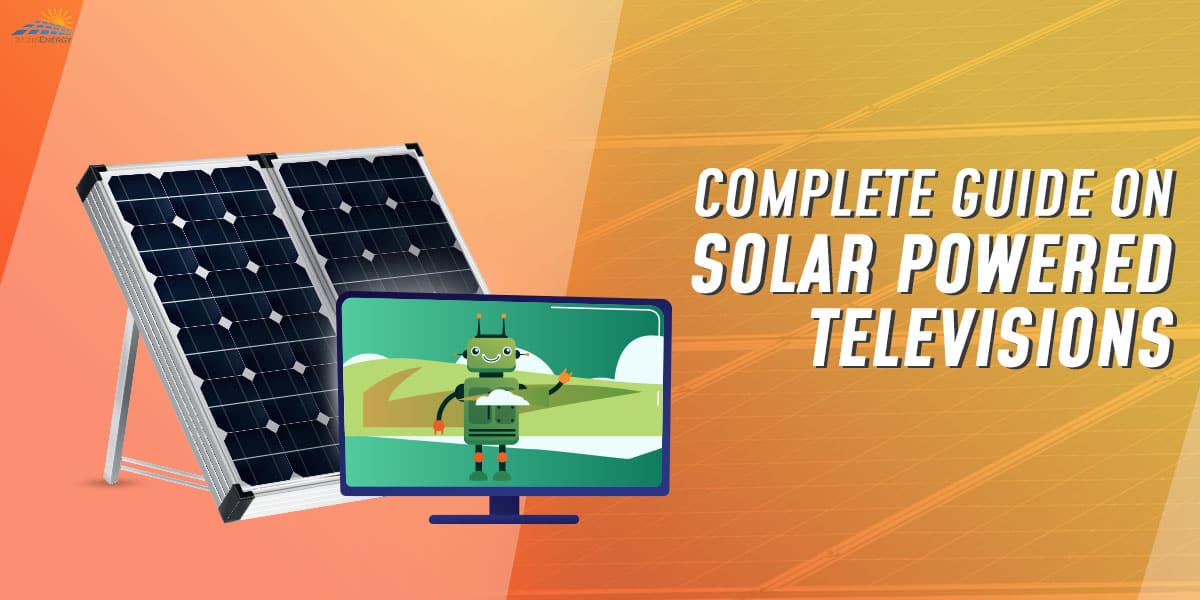
During these challenging times, we all have been forced to sit at home. As life gets harder outside the walls, our reliance on entertainment has increased drastically. When at home, the television is our primary source of entertainment. Often we spend countless hours glued to the television, binge-watching shows and eating as much food as we can.
This makes the TV one of the significant energy users in your house. Especially in these troubled times, the more time we spend watching TV, the more it adds to our utility bills. To cut down the costs, several homeowners have shifted towards using solar energy, which have its pros and cons.
Similarly, using solar powered TV can help you cut down on those utility costs without keeping you from continuous entertainment. You can use solar panels for TV.
In this article, we have listed out the complete guide on solar powered televisions. In addition, we have also listed out the best solar panels you can use to run your TV using solar energy.
Can You Run A TV On Solar Power?
Yes, it is possible to run a television using Solar Power. Since solar is a renewable energy source, it can help you drastically cut down on those utility bills. As the world towards a more eco-friendly solution, companies have slowly started shifting from using traditional energy sources to solar energy (read on difference between active and passive solar energy).
With solar energy quickly becoming a substitute for electricity, companies have introduced more and more devices compatible with solar energy. Such is the case with Television.
It is now possible to run a TV on solar power and without needing an off-grid power source. To run your TV on solar power, you need solar panels and a few additional equipment.
However, before you start using solar energy for your TV, you must ensure that your Television is compatible with this alternative energy source. This is because solar panels produce a Direct Current, whereas a Television uses Alternate Current, for that purpose you would need to have an inverter.
How To Run A TV On Solar Power TV?
As we mentioned above, a television uses AC, whereas a solar panel produces DC. To run the TV using solar, you can collect the DC power produced by the solar panels.
Once you collect it, you can store this DC in a battery/inverter, which automatically changes the power from DC to AC, in turn allowing you to power all your household tools. Converting DC to AC is one way of powering your TV or other solar-powered appliances.
However, with the rapid evolution of technology, you can now TVs with built-in solar panels that run directly by harnessing the sun’s power. These types of TVs are produced explicitly to help consumers dial down on their utility bills.
Solar-powered TVs generally tend to have a DC fan that runs directly by harnessing the sun’s power. Therefore, your fan will run even faster on bright sunny days.
1. How Much Electricity Does A TV Use?
The amount of electricity your TV uses is directly proportional to the time the TV is being turned on. Before making the shift to solar-powered televisions, you first have to understand how much energy your TVs consume.
To calculate the energy consumption, you have to calculate the TV’s kilowatt and its usage. For example: Using a plasma TV for three hours consumes nearly 280-500 watts.
Also, the amount of electricity your TV consumes also depends on the make and model of your TV. A high-definition TV typically consumes more power than regular TVs.
A 32-inch LED generally consumes around 150-watt energy, whereas a plasma TV consumes around 300-watt energy. The manufacturer and technology used in your TV are also deciding how much electricity your TV will consume.
To get the rough estimation of the annual power consumption of the TV as per the screen size, you can refer the table below:
| TV Size | Common Annual Power Consumption |
|---|---|
| 19 Inch | 33 kwh |
| 24 Inch | 38.1 kwh |
| 32 Inch | 51 kwh |
| 40 Inch | 58.8 kwh |
| 50 Inch | 136 kwh |
| 55 Inch | 151 kwh |
| 65 Inch | 185 kwh |
2. Solar Panels For TV
| Rank | PRODUCT NAME | SCORE | ||
|---|---|---|---|---|
|
1
1st Place |
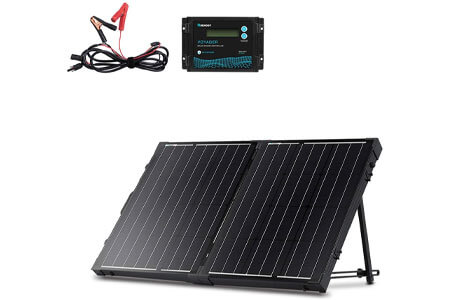
|
Renogy 100W Panel-20A Controller By Renogy |
5.0
|
Check Price |
|
2
Best Value |

|
DOKIO Foldable Solar Panel By Dokio |
4.9
|
Check Price |
| 3 |
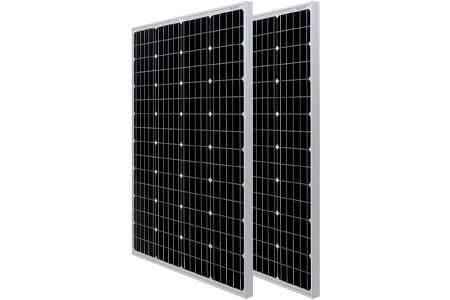
|
HQST 100W Monocrystalline Solar Panel By HQST |
4.7
|
Check Price |
To power your solar powered TV, you either need a single solar panel or multiple solar panels. However, before you run your Television using solar energy, you first need to understand your TV’s overall consumption rate and the energy production measurement of solar panels.
There are different types of solar panels to choose from. However, you need to consider the technology and the type of solar panel to match it with your appliances. It is always better to install an efficient solar panel to provide sufficient power to your TV and other home appliances.
Therefore, here are a few solar panels for TV
I. Renogy 100W Panel-20A Controller
The Renogy 100W Panel 20A Solar panel is fully adjustable and made out of corrosion-resistant aluminum.
This off-grid foldable solar panel is fully capable of delivering 500 Wh per day depending upon the intensity and availability of sunlight.
In addition, these solar panels are compatible with gel, sealed, lithium, and flooded batteries. It comes with a charge controller that displays all the information and data on an LCD.
Also, the negative charge ground controller protects your devices from overcharging, overcurrent, and overvoltage.
If you think the Renogy solar panel is not for you, you can continue checking the list, you should also check hoe Renogy competes against other leading brands such as Zamp and Go Power when thinking about buying a Renogy Solar Panel.
Pros
- High-Ideal Output
- Low Voltage System
- It comes equipped with a negative charge ground controller
Cons
- Not completely reliable
| Specifications | |
|---|---|
| Maximum Power | 100W |
| Voltage | 12V |
| Material | Aluminum |
| Weight | 7.83 Pounds |
| Dimensions | 24.8 x 20 x 2.8 inches |
II. DOKIO Foldable Solar Panel
The 100 Watt monocrystalline solar panel comes with a foldable solar panel and allows for easy connection between the battery clips and the battery, followed by a convenient carry-around handle.
The DOKIO foldable solar panel is completely waterproof and corrosions resistant, with heavy-duty latches for added longevity.
This green foldable solar panel is ideal for your RV, camping, and other off-grid usage.
Pros
- Portable
- Easy Installation
- Durable
Cons
- Expensive
| Specifications | |
|---|---|
| Maximum Power | 100W |
| Voltage | 12V |
| Material | Monocrystalline |
| Weight | 18.5 Pounds |
| Dimensions | 20.9 x 26 x 2 inches |
III. HQST 100W Monocrystalline Solar Panel
The HQST 100 W monocrystalline solar panels are currently one of the best available in the market.
This off-grid foldable solar panel is fully capable of delivering 500 Wh per day depending upon the intensity and availability of sunlight.
This monocrystalline solar panel comprises bypass diodes that minimize the power drop caused by shade to ensure maximum efficiency.
It is made up of anti-reflective, high transparency, and low-iron tempered glass designed explicitly to withstand harsh winds and rough climatic conditions.
In addition, the advanced encapsulation material makes it long-lasting and provides a long service life.
Pros
- Long Lifespan
- After-Sales Service
- Waterproof
Cons
- Expensive
| Specifications | |
|---|---|
| Maximum Power | 100W |
| Voltage | 12V |
| Material | Monocrystalline |
| Weight | 16.5 Pounds |
| Dimensions | 40.1 x 20.0 x 1.18 in |
3. How Many Batteries Are Required To Run A Solar Powered TV?
| Rank | PRODUCT NAME | SCORE | ||
|---|---|---|---|---|
|
1
1st Place |
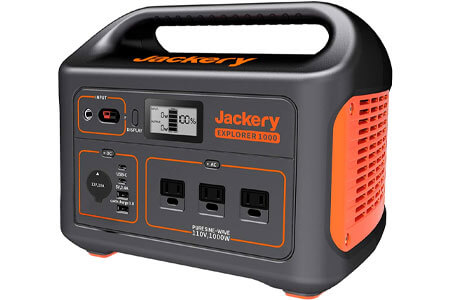
|
Jackery Portable Power Station Explorer 1000 By Jackery |
5.0
|
Check Price |
|
2
Best Value |
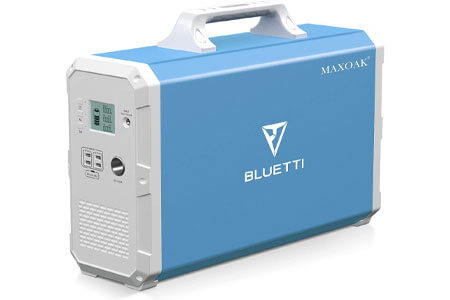
|
MAXOAK BLUETTI EB240 Portable Solar Generator By Maxoak Bluetti |
4.6
|
Check Price |
| 3 |
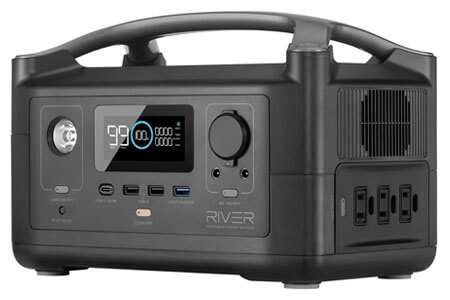
|
EF ECO FLOW Portable Power Station RIVER By Ef Eco Flow |
4.6
|
Check Price |
As we mentioned above, the number of batteries required to run a solar powered TV depends on the TV’s wattage and overall energy consumption.
A large HD TV or a plasma television ultimately consumes more energy than standard television. If you buy a TV with a power output between 60-80 watts, you need a single battery of approximately 1000 W to keep the TV running for 5 hours on a single charge.
Here are some of the different Solar-powered batteries ( generators ) which you can use to power all your solar-powered appliances.
I. Jackery Portable Power Station Explorer 1000
Jackery is one of the leading brands in terms of producing green power solutions. And the Jacekry Portable Power Station Explorer 1000 is the best fit to fulfill all your outdoor needs.
This 1000 W power station comes with 3 Pure sine wave AC outlets that simultaneously provide maximum power to all AC outlets.
In addition, it has 2 USB-C ports and 1 Quick Charge 3.0 port for faster charging. Professional MPPT technology provides faster solar recharge rates.
Pros
- MPPT Technology
- 4 Ways Of Recharging
- Can Power Up to 8 Outdoor Devices
Cons
- Expensive
- Cannot Support Devices Over 1000W
| Specifications | |
|---|---|
| Wattage | 1000W |
| Voltage | 110V |
| Power Source | Solar |
| Number of Power Outlets | 3 |
| Runtime | 5 Hours |
| Weight | 22 Pounds |
II. MAXOAK BLUETTI EB240 Portable Solar Generator
This MAXOAK BLUETTI EB240 Portable Solar Generator comes equipped with a massive 2400 Watt-hour lithium-ion solar-powered LG.
It is also one of the biggest solar-powered power stations with a pure sine wave inverter, providing a max output level of 1000 watts.
It weighs at around 38 pounds and has a solid handle on top, making it portable. Similar to the Jackery Explorer, the Maxoak Bluetti EB240 has an LCD on the front that indicates your current battery level and the amount of Watts going in through the AC and DC walls.
Pros
- Built-in MPPT Controller
- Automobile Level 3-C High Power Battery
- Dual Charging Feature
Cons
- No Quick-charge USB Support
| Specifications | |
|---|---|
| Wattage | 1000W |
| Voltage | 110V |
| Power Source | Solar |
| Number of Power Outlets | 2 |
| Runtime | 10 Hours |
| Weight | 48.5 Pounds |
III. EF ECO FLOW Portable Power Station RIVER
The EF Ecoflow River comes with 3 AC outlets that provide maximum power to all the connected devices. This 288 Wh solar power generator can power up to 10 devices simultaneously.
In addition, the EF Ecolflow has three sure pine wave AC outlets, and Ecoflow’s patented X-Stream technology can charge this power station from 0 to 80 in just one hour.
Meanwhile, the “Quieter Charging” feature allows you to switch to a quieter charging condition. The X-Boost technology can power up to 80% of your total home appliances, and this mode can be monitored using the Ecoflow App.
Pros
- 3 Pure Sine Wave AC Outlets
- X-Boost Technology For Faster Charging
- Can Power Up to 10 Devices Simultaneously
- Sustainable Solar Charging
Cons
- Expensive
- Cannot Support Devices Upto 1000 W
| Specifications | |
|---|---|
| Wattage | 720W |
| Voltage | 110V |
| Power Source | Solar |
| Number of Power Outlets | 3 |
| Runtime | 1 Hours |
| Weight | 16.8 Pounds |
Steps To Install A Solar Powered Television
When you install a solar panel, the panel sends charging electrons to the battery. Once the energy is stored, it is converted into AC and then passed to the television through an inverter. The sun delivers fresh electrons to offset the current pulled out of the battery and keeps your TV running for several hours.
To install a solar-powered TV, you need the following things.
- An AC Inverter that converts the Direct Current from the solar panels into AC
- A battery to feed the inverter ( preferably 12 volts )
- A charge controller can adjust the charge as per the battery’s requirements to prevent overcharging, overcurrent, or current overflow.
- A Portable solar panel. Note that the wattage depends on the size of your battery and whether you want the panel for the whole TV load or just for power conditioning.
To set up a solar powered TV, you need to arrange all the things mentioned in reverse order. To set up your solar-powered TV, follow the steps given.
Step 1. Install the solar panels on the roof. Ensure that you install these panels in an area exposed to maximum sunlight
Step 2. Bring the wires to the side of your house
Step 3. Mount the charge controller on a wall.
Step 4. Install the battery on the floor. (Note that the inverter should be in close proximity)
Step 5. Run the extension cord to the TV.
Note that the battery stabilizes the electric power and accordingly avoids voltage and frequency shifts of the inverter’s AC.
The Bottom Line
We hope our article successfully walked you through everything you need to know about solar powered televisions. Solar power is a renewable source of energy that harnesses power directly from the sun.
This renewable energy source is the perfect alternative to traditional sources of electricity and can drastically help cut down on your utility bills.
To run a TV using solar energy, you need one or multiple solar panels depending upon the total wattage and energy consumption. These solar-powered batteries will help keep the TV running for almost 6 hours under a full charge.

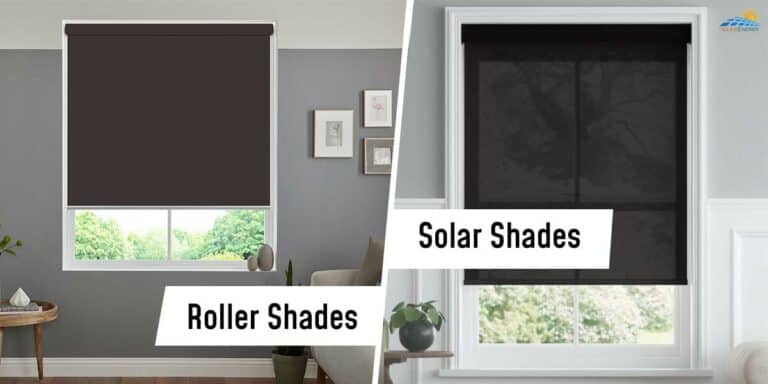
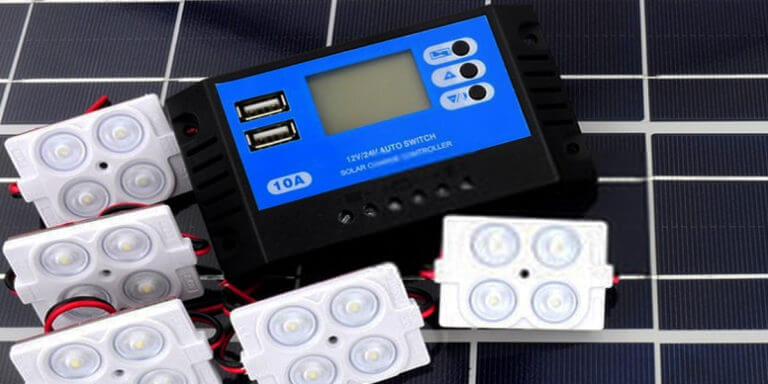


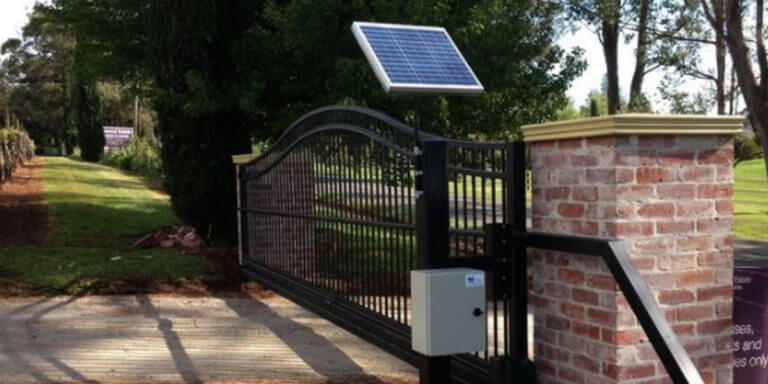

I want to use solar energy for my appliances like tv and refregirator….and I don’t know what the equipments i uses …I know the solar panel but I don’t know how many watts I uses and the other equipments that I uses…can you give all the listing of installing solar energy for my tv sets and refregirator?…. thanks for the reply…